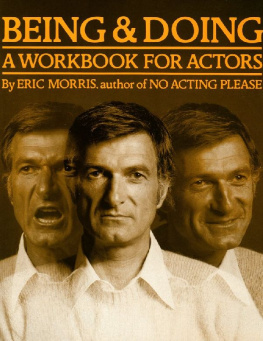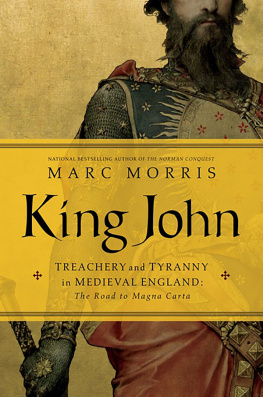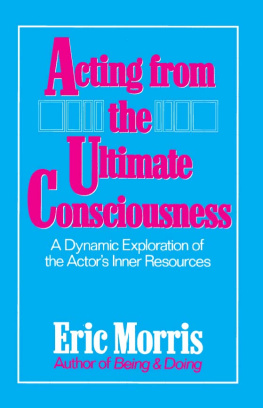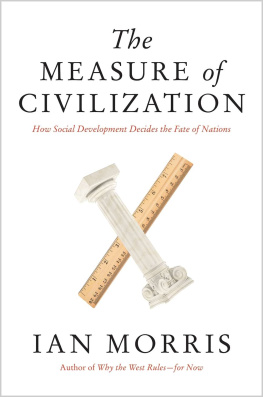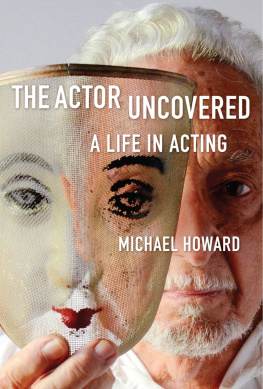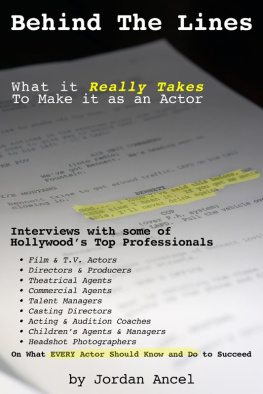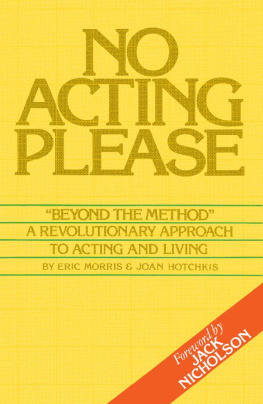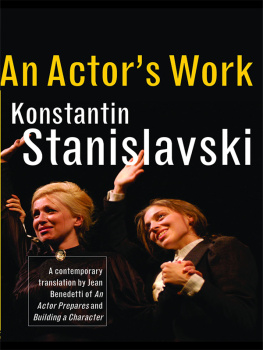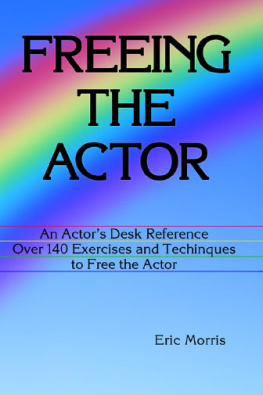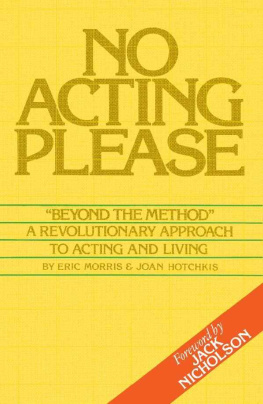
BEING & DOING
A WORKBOOK FOR ACTORS
ALSO BY ERIC MORRIS
No Acting Please
Irreverent Acting
Acting from the Ultimate Consciousness
Acting, Imaging and the Unconscious
AUDIO TAPES
The Craft of Acting
The Megapproaches
Imaging for Acting
THE ERIC MORRIS ACTORS WORKSHOP IS LOCATED AT:
5657 Wilshire Blvd., Los Angeles, CA 90036 (323) 466-9250
For further information on Eric Morris,
his work, the books and audio tapes visit
our web site: www.ericmorris.com
BEING & DOING
A WORKBOOK FOR ACTORS
By ERIC MORRIS, author of NO ACTING PLEASE
Ermor Enterprises
Copyright 1998 by Eric Morris.
All rights reserved.
Printed in the United States of America.
No part of this book may be reproduced or transmitted in any form or by any means, electronic or mechanical, including photocopying, without permission in writing from the publisher: Ermor Enterprises, 8004 Fareholm Drive, Los Angeles, CA 90046.
International Standard Book Number: 0-9629709-0-5
Designed by John M-Rblin
Distributed by S.C.B. (800)729-6423
PREFACE
Being and Doing is not just a title; it embodies the philosophy of an entire approach to acting. You see people busily DOING things every day of your life: pursuing their careers, talking, eating, laughing, crying, arguing, being sad and happy. What makes them do what they do? Is it arbitrary? Is it instinctive? Whatever it is, it certainly comes from impulses that stimulate the need to do.
My point is that in real life, our actions are the result of real impulses that cause responses expressed in action or emotion, while on the stage or in films we often see actors DOING things that seem to have no real origin. It appears that the actors emotions are there because they are supposed to be, and for no other reason. When that happens, and it happens quite often, behavior on the stage has no organic origin and denies reality. The actor is out of touch with his own reality and is involved with the production of nonauthentic emotional expressions. This leads to presentational acting which is without dimension or spontaneity.
The work that I am involved with, and what this book is about, is called BEING. It is dedicated to the search for truth in each actorto what he or she really feels and to the expression of that moment-to-moment reality. That is the very basis from which theatrical truth comes. The exercises in the section dealing with the instrument, and some in the section on craft, are designed to eliminate the blocks that keep the actor from feeling comfortable reaching the BEING state. Truth comes from truth, and cannot come from any other place.
While this book is in no way a complete treatise on my approach to acting, it is a good workbook that you can use to help yourself solve acting problems. The craft section explores the most important and applicable craft techniques, and these approaches are described very simply. In the business section I attempt to share some experience with the commercial end of the profession and suggest ways that you might avoid some of the pitfalls.
All the lessons are designed and constructed in small increments and can be extracted from the text and worked on for a day or more. You may skip around, using exercises from the instrumental section at the same time that you are working in craft areas. You may repeat some exercies over and over again. A number of exercises are described repeatedly in the text, and there are reasons for that. Some exercises can be used for several purposes, while others have a number of different emphases.
Have fun with the work, and feel free to involve other actors whenever possible. If you follow the format of the book, it will be very easy to establish a daily working schedule.
The lessons in this book are based on a column, The Craft Corner, that I wrote over a three-year period for the Dramalogue.
Eric Morris
THE INSTRUMENT
THE INSTRUMENT
This section of the book deals with YOU, your body, your intellect, your emotions, and your voice. Just as a musician has an instrument to play, the actors instrument is himself. That instrument must be tuned and ready to play, and that is what I refer to when I speak of instrumental preparation. We are born into a world that is inhibiting and judgmental. We develop protections and blocks that keep us from realizing our emotional potential, not to mention the ability to express ourselves freely. Those insulations block us off not only from other people, but also from ourselves. What must be done is to eliminate all the blocks and fears that hold the bulk of our creative talent inside.
If you have chosen to be an actor, you have a responsibility to stimulate and express the entire range of human emotions. The idea is not just to represent the emotions but to experience and express them! Yet after spending twenty years or more stifling your impulses, you cannot expect to step on a stage and be emotionally as free as a bird. So your first priority is to concentrate on eliminating your emotional obstacles. That is where the instrumental therapy emphasis comes in. Over the years I have developed and discovered hundreds of techniques and exercises that specifically deal with problem areas in self-expression. These techniques are designed to be used repeatedly in order to tear down the walls that have been built up over a lifetime.
BEING is the word I use to represent the goal of this kind of preparation. BEING is the behavioral state in which you are comfortable allowing yourself to feel and express all emotions impulsively, doing no more nor less than you feel. It is not just something to be desired; it is totally necessary in order to become an organic and creative actor. Mastering the craft of creating realities is dependent on you, the actor, being ready to open yourself up as a human being. If you do not, then you cannot be reached on an authentic level and your acting remains superficial.
The instrumental section is dedicated to problems, common and unique, that relate directly to YOU. Some of the exercises show you how to find your obstacles and eliminate them. You should work on the instrumental exercises in combination with the craft exercises that are described in the second section of the book. Of course you cannot simply read a book and become an actor. But if you do the work outlined on these pages and do it consistently, you will achieve the BEING state and learn how to use a craft that will put you way ahead of most other actors.
THE BEING STATE
For many years I have been working on a system of acting, based on The Method, that I call BEING. As an actor I was constantly frustrated with Method techniques that didnt work for me, and as a result I started to ask a lot of questions. What were the obstacles that stood between me and using techniques that were supposed to work? Why did other actors have similar difficulties with these approaches? Was the Stanislavski system easier to discuss than it was to use?
I started on a journey that took the better part of twenty years. After much experimentation, and the cooperation of hundreds of my students and contemporaries, I developed an approach that is dedicated to seeking and finding the roads in to the self. It eliminates lifelong inhibitions against the acquisition of a state of BEING from which all theatrical truth can emanate. From this BEING state you can use the Method.
BEING YOU
The very best thing you have is YOU! Who you are, what you are, how you think, and the unique individuality that is YOU. There is not another one like you in the entire world. Even if you dont believe this, just for a moment suppose that its true. If you agree that you are truly special (and you are), then what are your responsibilities to develop and use your unique qualities? What must you do to BE who you are in relation to all circumstances? Yes, you must do many things to free yourself of the restrictions that have been imposed on you since birth!
Next page
